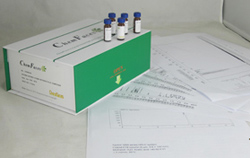Hot Products



| Catalog No. | Information |
| CFN93228 | Raspberryketone glucoside Raspberry ketone glucoside has lasting effects for the inhibition of melanogenesis and various melanogenic factors after the degradation in the skin. |
| CFN92605 | RA-V RA-V is an potential anti-angiogenic agent, exhibits anti-angiogenic activities in HUVEC and HMEC-1 cell lines with changes in function of these endothelial cells. RA-V also has anti-cancer activity, is a potential anti-metastatic agent in breast cancer, and likely acts via PI3K/AKT and NF-κB signaling pathways in both ER-positive and ER-negative breast cancer cells. |
| CFN99110 | Rebaudioside A Rebaudioside A, an natural sweetening ingredient, is approximately 250 to 300 times sweeter than sucrose, do not contribute calories or carbohydrates to the diet and do not affect blood glucose or insulin response. It is a α-glucosidase inhibitor with IC50 of 35.01 μg/ml. |
| CFN90470 | Rebaudioside B Rebaudioside B tastes about 150 times sweeter than sucrose and it is non-caloric. |
| CFN90258 | Rebaudioside C Rebaudioside C belongs to the family of Steviol Glycosides. It is a natural constituent of the plant Stevia rebaudiana Bertoni and used as natural sweeteners to diabetics and others on carbohydrate-controlled diets. |
| CFN90257 | Rebaudioside D Rebaudioside D is a potential sweetener. Rebaudioside D shows similar stability when exposed to simulate stomach and small intestine fluids, with susceptibility to hydrolytic degradation by enteric bacteria collected from the cecum. |
| CFN91096 | Rebaudioside E Reference standards. |
| CFN95215 | Rebaudioside F Reference standards. |
| CFN70259 | Rebaudioside M Rebaudioside M is a natural sweetener. |
| CFN91167 | Rebaudioside N Reference standards. |